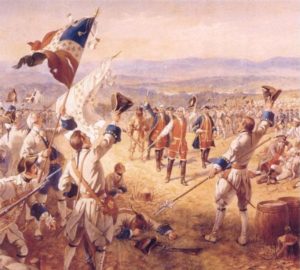Andebit et beaqui corendit, ut quostes esciendion re dit ad et prae parion es quia quas alibus sam, omnim faciden ducipidiat arum autem nobis enis es voat

6. Driving to Willsboro: Preparing for War
The British had to assemble huge numbers of soldiers and laborers, a tremendous amount of supplies, and build the vehicles to transport it all. Yet planning was lacking.
Listen to the Turning Point Trail Site 6 Audio Narration:

Fort Ticonderoga was the first step in General John Burgoyne’s plan to seize control of the strategic waterway. The fort commanded a tactical position on Lake Champlain. Burgoyne would have to take control of the Rebel stronghold, but the fort had a reputation for being extremely well fortified.
The French constructed Fort Carillon in 1755, during the French and Indian War. In 1758, 4,000 Frenchmen defended the fort, against a force nearly four times their size. The British only overtook it when gains elsewhere forced the French to abandon it. The British repaired the fort and renamed it Ticonderoga, but only a skeletal crew was there when Rebels Benedict Arnold and Ethan Allen took it without a fight in 1775. When General Guy Carleton returned to Canada at the end of the 1776 campaign, there were about 13,000 men at Ticonderoga—and rumors stirred about the growing numbers of Rebels at the fort. Burgoyne knew he needed to be prepared for a fight.
Historians have called Burgoyne’s force the best-equipped army that had ever landed on the continent and with the finest train of artillery known at the time. Major General William Phillips led the artillery regiments. A self-made man, Philips excelled as an artilleryman, mastering every facet of artillery warfare.
Like General Friedrich Adolf Riedesel, Philips ascended the ranks after gaining favor at the infamous Battle of Minden. During the battle, two brigades of British officers advanced on the French lines completely unsupported. Philips saw this and brought his heavy artillery up at a gallop for over five miles. This was unheard of and thought to be impossible, but his decisive action forced the French to withdraw. This was the type of man that Burgoyne needed to overwhelm the Rebels entrenched at Ticonderoga, but the movement of the guns, the men, and all their supplies would all depend on General Guy Carleton, who had been in command of Quebec since 1768.
Considering the length of time Carleton had to prepare for the 1777 campaign season, he had done very little. The artillery required heavy-duty wagons and teams of horses or oxen to haul them, but not enough animals were available for the artillery or for all the other supplies that needed to be transported, such as tents, blankets, and medical supplies. Because of Carlton’s lack of preparation, carts and wheels were constructed of raw, green lumber. The wheels also lacked iron rims, which are necessary for negotiating the rough and rutted roads across the wilderness.
Carleton had devoted some time to recruiting Canadian soldiers but fell far short of the 3,000 men Burgoyne requested. Burgoyne didn’t care much for the recruits he did get, which he described as “awkward, ignorant, disinclined to the service, and spiritless” with “no promise of use in arms.”
While the Canadians were not inclined to side with the Rebels, they were not enthusiastic about fighting for the British. Their lack of enthusiasm is understandable as Carleton had to resort to a form of forced labor to enlist the requested number of axmen and laborers. They had to abandon their farms to tend to the supply-line, cut roads, build fortifications, and whatever other tedious work was needed to tend to the provisions of troops on the front-line.
The British, Germans, Loyalists, Canadians, and Indians amounted to about 10,000 soldiers. Together with the doctors, cooks, engineers, laborers, and women and children camp followers, the procession up the lake totaled roughly 14,000 people. It was like moving a small city.
Travel Tools
Start track 6 when track 5 ends. Follow Route 22 South to Willsboro.
Local Bites:
- Turtle Island: A sweet spot with great food, craft beers, and plenty of cocktails. 3790 Main St, Willsboro.
- Ethel’s Dew Drop: Willsboro’s quintessential roadside symbol of summer. Hamburgers, hot dogs, curly fries, and ice creams of all flavors. 3901 Route 22, Willsboro.
- The Willsboro Diner: Homey, small-town diner with inexpensive food. Great for breakfast. 3745 Main St, Willsboro.
CLICK TO ADVANCE TO SITE SEVEN
First-Hand Accounts
The rumors of the Rebel forces at Fort Ticonderoga were highly inflated:
“There were insurmountable defenses, large fortifications, an army of 60,000 men not counting their fleet on Lake Champlain. Terrible news! If all this is true, our small army will have very little effect and not get very far.” –Julius Wasmus
General John Burgoyne’s thoughts on preparing for the war against the American Rebels:
“A business thus complicated in arrangement; in some parts unusual in practice, and in other perhaps difficult, can only be carried to the desired effect by the peremptory powers, warm zeal and constant opinion of the governor…The assembly of savages, and the Canadians will also entirely depend upon the governor…Under these considerations it is presumed that the General Officer employed to proceed with the Army will be held to be out of the reach of any possible blame ‘till he is clear of the Province of Canada, and furnished with the proposed supplies.” –Burgoyne’s Thoughts for Conducting War from the Side of Canada


